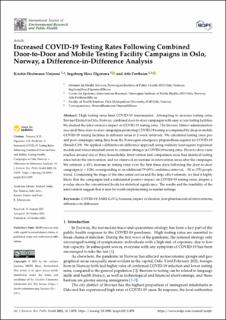| dc.contributor.author | Vinjerui, Kristin Hestmann | |
| dc.contributor.author | Elgersma, Ingeborg Hess | |
| dc.contributor.author | Fretheim, Atle | |
| dc.date.accessioned | 2021-12-07T14:33:21Z | |
| dc.date.available | 2021-12-07T14:33:21Z | |
| dc.date.created | 2021-11-15T08:45:45Z | |
| dc.date.issued | 2021-10-21 | |
| dc.identifier.citation | International Journal of Environmental Research and Public Health (IJERPH). 2021, 18 (21), . | en_US |
| dc.identifier.issn | 1660-4601 | |
| dc.identifier.uri | https://hdl.handle.net/11250/2833202 | |
| dc.description.abstract | High testing rates limit COVID-19 transmission. Attempting to increase testing rates, Stovner District in Oslo, Norway, combined door-to-door campaigns with easy access testing facilities. We studied the intervention’s impact on COVID-19 testing rates. The Stovner District administration executed three door-to-door campaigns promoting COVID-19 testing accompanied by drop-in mobile COVID-19 testing facilities in different areas at 2-week intervals. We calculated testing rates pre-and post-campaigns using data from the Norwegian emergency preparedness register for COVID-19 (Beredt C19). We applied a difference-in-difference approach using ordinary least square regression models and robust standard errors to estimate changes in COVID-19 testing rates. Door-to-door visits reached around one of three households. Intervention and comparison areas had identical testing rates before the intervention, and we observed an increase in intervention areas after the campaigns. We estimate a 43% increase in testing rates over the first three days following the door-to-door campaigns (p = 0.28), corresponding to an additional 79 (95% confidence interval, −54 to 175) people tested. Considering the shape of the time series curves and the large effect estimate, we find it highly likely that the campaigns had a substantial positive impact on COVID-19 testing rates, despite a p-value above the conventional levels for statistical significance. The results and the feasibility of the intervention suggest that it may be worth implementing in similar settings. | en_US |
| dc.language.iso | eng | en_US |
| dc.publisher | MDPI | en_US |
| dc.relation.ispartofseries | International Journal of Environmental Research and PuInternational Journal of Environmental Research and Public Health (IJERPH);Volume 18 / Issue 21 | |
| dc.rights | Navngivelse 4.0 Internasjonal | * |
| dc.rights.uri | http://creativecommons.org/licenses/by/4.0/deed.no | * |
| dc.subject | COVID-19 | en_US |
| dc.subject | SARS-CoV-2 | en_US |
| dc.subject | Humans | en_US |
| dc.subject | Impact evaluations | en_US |
| dc.subject | Non-pharmaceutical interventions | en_US |
| dc.subject | Difference-in-differences | en_US |
| dc.title | Increased COVID-19 testing rates following combined door-to-door and mobile testing facility campaigns in Oslo, Norway, a difference-in-difference analysis | en_US |
| dc.type | Peer reviewed | en_US |
| dc.type | Journal article | en_US |
| dc.description.version | publishedVersion | en_US |
| dc.rights.holder | © 2021 by the authors. | en_US |
| cristin.ispublished | true | |
| cristin.fulltext | original | |
| cristin.qualitycode | 1 | |
| dc.identifier.doi | https://doi.org/10.3390/ijerph182111078 | |
| dc.identifier.cristin | 1954444 | |
| dc.source.journal | International Journal of Environmental Research and Public Health (IJERPH) | en_US |
| dc.source.volume | 18 | en_US |
| dc.source.issue | 21 | en_US |
| dc.source.pagenumber | 11 | en_US |

